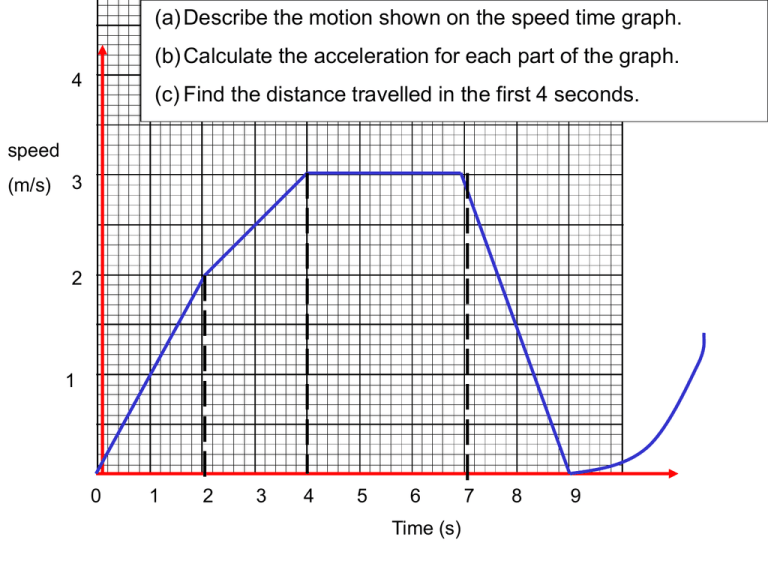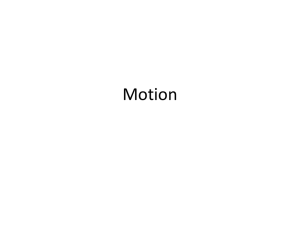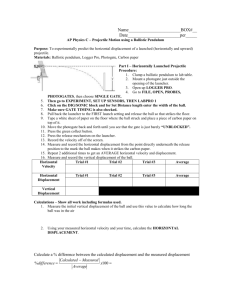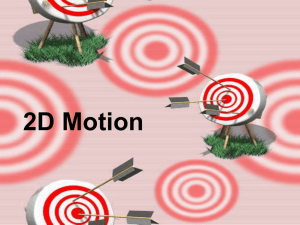graphs and equations of motion
advertisement

(a) Describe the motion shown on the speed time graph. (b) Calculate the acceleration for each part of the graph. 4 (c) Find the distance travelled in the first 4 seconds. speed (m/s) 3 2 1 0 1 2 3 4 5 6 Time (s) 7 8 9 Velocity (a) Find the acceleration for each part of the graph. m/s (b) Draw an acceleration time graph 3 (c) Find the maximum displacement from the start. 2 (d) Find the final displacement. 1 0 -1 -2 -3 1 2 3 4 5 6 7 8 Time (s) Sketch graphs v t a t Ball falling from rest – up direction is positive v Notes: + 0 t - All red lines have same gradient – (on Earth this will be – 9.8 m/s2 as this is acceleration due to gravity). Above the time axis the ball is moving upwards, below it is moving downwards In your group sketch a graph showing the motion of a ball which is thrown up. Start the instant after the ball leaves your hand. Take up as positive. Now do tutorial questions 27 to 32 SAQ to Qu 24 2010 Higher paper Qu 1,2 Purple book Ex 1.2 Equations of motion Third year v=d÷t no acceleration Fourth year a = (v – u) ÷ t uniform acceleration distance = area under speed time graph Higher v = u + at uniform acceleration s = ut + ½ at2 v2 = u2 + 2as v = ½( u + v) displacement = area under velocity time graph Advanced Higher - accelerations which are not uniform - very fast speeds, relativity Deriving Equations of motion v v t – time taken u - initial velocity v – final velocity a – acceleration s - displacement u Acceleration = gradient of graph t a=v–u t so v = u + at equation 1 t Displacement = area under the graph s = ut + ½(v – u)t s = ut +½at2 but v = u + at so (v – u) = (u + at – u) = at equation 2 Displacement = area under the graph s = ut + ½(v – u)t = ut + ½vt -½ut s = ½(u + v) To eliminate t v = u + at so t=(v–u)÷a s=½(u+v)t = ½ (u + v )( v – u ) ÷ a 2as = ( u + v ) ( v – u ) 2as = uv – u2 + v2 – uv 2as = - u2 + v2 v2 = u2 + 2as equation 3 Note you are unlikely to be asked to derive this equation. Examples 1. A car travelling at 20 m/s accelerates uniformly at 0.5 m/s2 until it is travelling at 30 m/s. Calculate the distance travelled by the car during this time. 2. A toy rocket is launched vertically and reaches a height of 60 m. What was its launch speed? Now try tutorial questions 33 to 36 Qu 37 a challenge, there is more than one way to reach the same answer. Which do you find easier Qu 39 to 42 Up to SAQ 36 Purple book Chp 1.3 Always check on signs + - + - + - Projectiles The only force which acts on a projectile is the force due to gravity ( weight) We need to resolve the velocity into its horizontal and vertical components v v Horizontal velocity Vertical velocity vH vv Down + ve t No force in horizontal direction so constant velocity t Weight acts downward so accelerates at 9.8 m/s2 down Example A car travelling with a horizontal speed of 20 m/s goes off the top of a cliff. It lands 30 m from the foot of the cliff (i) How high was the cliff? (ii) What was the car’s velocity just before it hit the ground ? Tutorial questions 43 to 46 SAQs up to 39 Purple book Ex 1.4 Extra question satillite Example A basket ball player throws the ball at 600 to the horizontal and scores a basket. The foot of the basket was 12m away. If the ball takes 2s to reach the basket find:(a) The initial speed of the ball. (b) The height of the basket above the initial position of the ball. Tutorial Qu 47 to 50 SAQ up to 41 Purple book Ex 1.5 Estimate your take off velocity in a standing long jump. Step 1 Vertical jump Measure maximum vertical displacement, sv Calculate initial vertical velocity, uv and then the time for jump, t. Step 2 standing long jump sh maximum horizontal distance assume you stay in the air for the same length of time as your vertical jump ie uv and t will be the same as step 1. Calculate the horizontal velocity, vH Step 3 calculate take off velocity from uv and uH Do you think the assumption in step 2 is justified? If not, is the calculated value for horizontal velocity too big or too small? The world record for the standing long jump is 3.71 m











